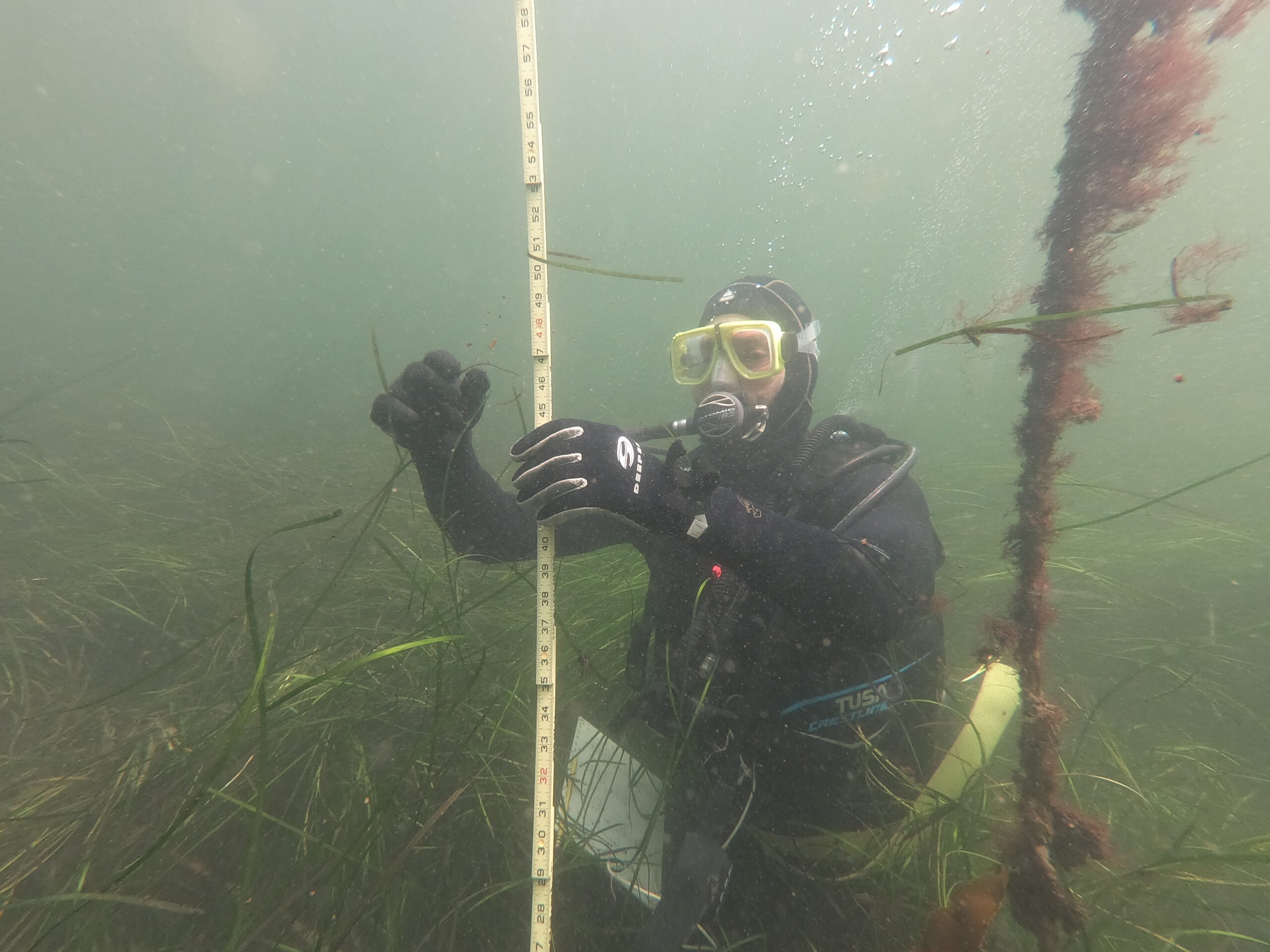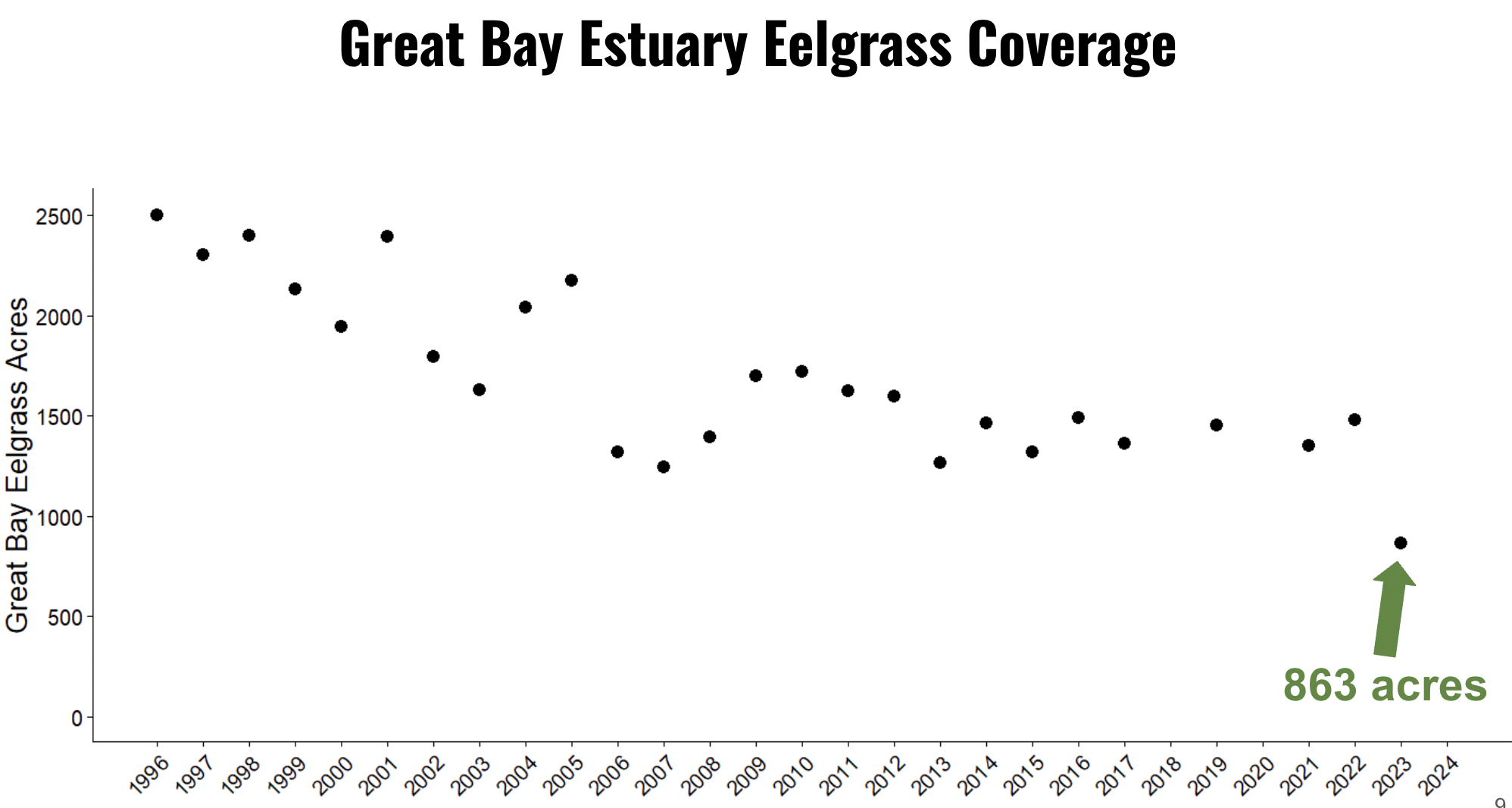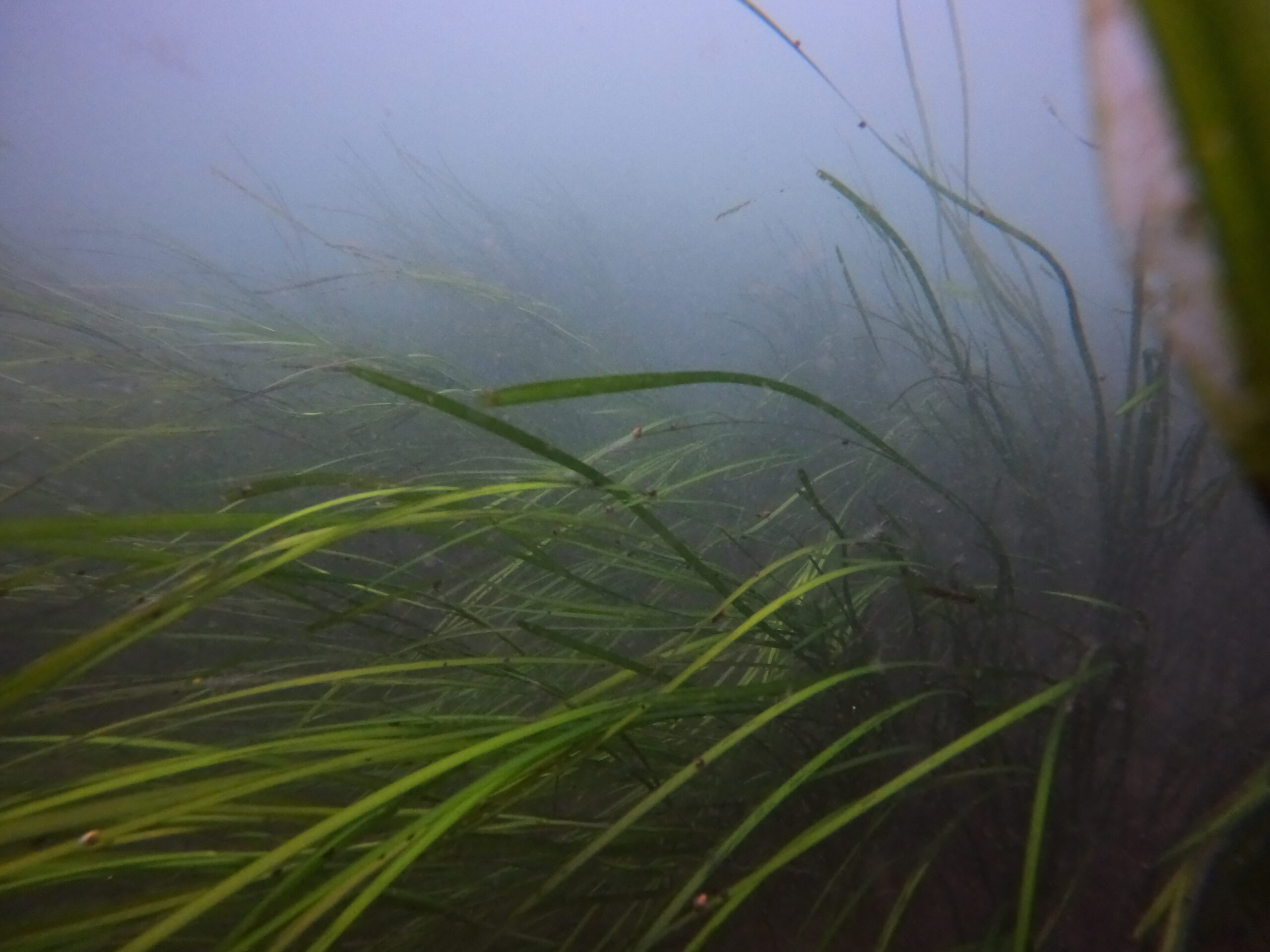Introduction
Welcome to our deep dive into the world of eelgrass! Zostera marina, known as eelgrass, plays a critical role in our estuaries. Eelgrass relies on high water quality to thrive and is vulnerable to pollution from nutrients and sediments. Therefore, tracking its health serves as an important indicator of estuarine well-being. In this post, we will explore the importance of eelgrass, the threats it faces, and its role in our estuaries. Learn about PREP's monitoring and restoration efforts, and get the latest update on eelgrass health in Great Bay as of Spring 2024.
How Eelgrass Supports Estuaries
For estuaries to thrive, water quality is necessary. Eelgrass supports water quality, in addition to providing many other functions. Some of the valuable qualities of eelgrass include:
- Water Filtering - In absorbing pollutants and excess nutrients like nitrogen, capturing and storing carbon, and encouraging suspended materials to settle, eelgrass filters water and improves water quality. The roots of eelgrass contribute to water filtration by trapping and stabilizing loose sediments. This allows for more light penetration.
- Increase Oxygen Levels - As a photosynthetic plant, eelgrass increases oxygen levels and acts as a buffer against the effects of ocean acidification (water becomes more acidic with an increase of carbon dioxide in the atmosphere, mainly caused by burning fossil fuels).
- Source of Aquatic Food - The plant material of eelgrass provides food for many aquatic species.
- Erosion Control - Eelgrass slows water flow, affecting wave energy, and as a result, reducing coastal erosion.
- Habitat Formation - Eelgrass beds provide habitat for fish, shellfish, crabs, lobsters, and other species.
What Threatens Eelgrass
As highlighted in PREP’s 2023 State of Our Estuaries report, eelgrass in the Great Bay Estuary is sensitive to the following factors:
- Excessive nutrients like nitrogen prompt seaweed growth, epiphytes (algae that grow on eelgrass leaves), and phytoplankton, all of which ultimately overshadow eelgrass by competing for sunlight. Nitrogen increases also present a challenge since New England is seeing many more rainy days than it used to.
- Suspended sediments and, to a lesser extent, chromophoric dissolved organic matter (CDOM) obstruct the light necessary for eelgrass. These factors, too, are affected by excessive rainfall.
- Eelgrass is vulnerable to rising water temperatures resulting in shallow waters exhibiting good water quality but that are excessively warm. In contrast, deeper waters remain cooler but pose challenges for eelgrass due to insufficient light at the bottom of the seafloor. Some refer to this as the “pinch.” Eelgrass, especially in the Great Bay as opposed to Portsmouth Harbor, can get "pinched" between clear but warm waters and deeper waters where light does not penetrate to reach the grass.
- Habitat disturbance in eelgrass occurs with extreme freshwater flow events that affect salinity.
How PREP Monitors Eelgrass Health
PREP is concerned with four types of data regarding eelgrass:
- Average canopy height
- Density
- Biomass
- Coverage
Our scientists perform routine dives, during some of which they measure the height of eelgrass blades at our sites (Image 1).

Image 1. Measuring eelgrass
Divers also measure the density of eelgrass. Measured in shoots per meter squared, density counts go hand-in-hand with canopy height measurements and help our scientists calculate biomass. Biomass is the weight of the plant matter per area and is calculated by weighing samples and dividing the weight of the sample by the number of shoots.
Quadrats are used to measure percent cover as shown in Movie 1. These tools sit at the bottom of the estuary floor to help PREP scientists visually assess eelgrass percent cover and density, and calculate biomass. As these numbers decline, so do the beneficial functions of eelgrass. We hope to have larger and denser plants because it means the eelgrass is providing more of the ecosystem functions that make them so valuable.
Eelgrass Decline: From The 1990s to Today
Regular assessments of eelgrass have been conducted since 1982 with a “peak year” in 1996. As seen in Graph 1, from 1996 to 2024, we see an overall trend of eelgrass decline. Looking from 2006 to the current day, each recovery is further from the 1996 peak. Today’s eelgrass coverage is at its lowest at only 863 acres.

Another date of importance in the history of eelgrass in the Great Bay Estuary is the Mother’s Day Storm of 2006. The storm dramatically increased the amount of freshwater and the delivery rate of that water to our estuaries. This spiked nutrient levels and drastically decreased salinity levels, which caused a loss of eelgrass. Since the storm, eelgrass acreage has remained rather flat in the estuary. In Portsmouth Harbor, however, numbers began to increase in 2010, but it is important to note that there are many differences between Portsmouth Harbor and the rest of the Great Bay. These differences that may account for varying trends are hydrodynamic, sediment, temperature, and ecological differences. To learn more about these differences, visit the State of Our Estuaries website.
2023 was the rainiest “growing season” on record. Growing season is when eelgrass sees most of its growth between April and August. During 2024, eelgrass decreased significantly, reaching its lowest point since 1989. In 1989, the Great Bay Estuary was hit by a “wasting disease” episode. This natural disease consists of infections that spread through leaf-to-leaf contact. Today, wasting disease continues to impact our waters, though on a much smaller scale. Other negative impacts on eelgrass come from invasive green crabs and other species like horseshoe crabs and geese. The hardening of shorelines and dredging also contribute to eelgrass decline. However, the most significant threat to eelgrass is nutrient and sediment pollution.
How PREP Supports Eelgrass Restoration
Eelgrass performs essential functions, and healthy eelgrass populations indicate good water quality, making their restoration vital for ensuring the resilience of estuarine environments. Since 2021, PREP has been working with partners in the region on eelgrass restoration projects to facilitate the natural recovery of our eelgrass beds.
To restore, we use techniques such as the Horizontal Rhizome Method (HRM) and Transplanting Eelgrass Remotely with Frames (TERFs), and we are looking to incorporate eelgrass seeding in the near future. The PREP goal is to increase eelgrass distribution to 2,900 acres in the Great Bay Estuary. This does not, however, apply to the Hampton-Seabrook Estuary since eelgrass is not and has never been abundant there.
In March 2024, our scientists Kalle Matso and Nate Gruen dove into the waters of Great Bay to look for eelgrass seedlings. Very few plants were found at three of the four sites they visited. However, eelgrass seedlings could be found consistently scattered around, about an inch or two above the surface at one site in the Western Great Bay (Movie 2).
Then, our scientists checked whether plants were connected to an underground root system or if they were growing from a single seed. As visible in Movie 3, all the tested seedlings came from individual seeds. With the coming of spring, there is new hope for eelgrass in Great Bay!
References:
- Dr. Kalle Matso, Piscataqua Region Estuaries Partnership; Director
- Nate Gruen, Piscataqua Region Estuaries Partnership; Field Scientist
- Trevor Mattera, Piscataqua Region Estuaries Partnership; Habitat Program Manager
- https://greatbay.org/wp-content/uploads/2022/01/GBM-Winter-2022-F-Lo-res.pdf
- https://link.springer.com/article/10.1007/s12601-022-00054-2#:~:text=Seagrass%20biomass%20per%20shoot%20was,total%20number%20of%20its%20shoots.
- https://oceanservice.noaa.gov/facts/acidification.html
- https://naturalhistory.si.edu/sites/default/files/media/file/seagrass-monitoring-activity.pdf
- https://www.nature.com/articles/s41598-018-35670-3
- https://www.fisheries.noaa.gov/feature-story/importance-eelgrass#:~:text=Eelgrass%20provides%20a%20number%20of,such%20as%20the%20Pacific%20herring.
- https://www.researchgate.net/publication/246016857_Eelgrass_Wasting_Disease_Cause_and_Recurrence_of_a_Marine_Epidemic
- https://www.researchgate.net/publication/308894054_Seagrasses
- https://www.researchgate.net/publication/313844652_Zostera_Biology_Ecology_and_Management

